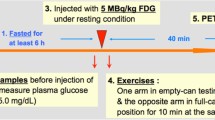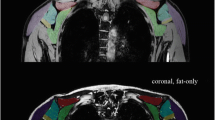Abstract
Objective
To investigate the muscle activity patterns of the glenohumeral joint during internal rotation both with the arm at 0° and 90° of abduction using 2-deoxy-2-[18F] fluoro-d-glucose (FDG) positron emission tomography (PET) and magnetic resonance imaging (MRI).
Materials and methods
Six healthy male volunteers underwent PET examination after performing active glenohumeral internal rotation exercise using an elastic band both with the arm at 0° and 90° of abduction. As a control, PET scan under resting condition was also performed. The exercise was performed before and after 18 fluorodeoxyglucose injection. Each PET image was fused to the corresponding MRI to identify each muscle. The standardized uptake value (SUV) of each muscle was compared between the two arm positions.
Results
With the arm at 0° of abduction, the SUV increased significantly after exercise both in the middle and inferior 1/3 of the subscapularis, which were significantly higher than that of the superior 1/3 of the subscapularis (P < 0.05). The SUV of the inferior 1/3 of the subscapularis was significantly higher at 90° of abduction than at 0° of abduction and was significantly higher than that of the superior 1/3 at 90° of abduction (P < 0.01). The SUV after exercise in the inferior infraspinatus and teres minor increased.
Conclusions
The middle and inferior parts of the subscapularis are the main shoulder internal rotators in 0° of abduction, whereas the inferior part of the subscapularis is the main internal rotator in 90° of abduction.






Similar content being viewed by others
References
Burkhart SS, Morgan CD, Kibler WB. The disabled throwing shoulder: spectrum of pathology part I: pathoanatomy and biomechanics. Arthroscopy. 2003;19(4):404–20.
Kibler WB, Chandler TJ, Uhl T, Maddux RE. A musculoskeletal approach to the preparticipation physical examination. Preventing injury and improving performance. Am J Sports Med. 1989;17(4):525–31.
Aldridge R, Stephen Guffey J, Whitehead MT, Head P. The effects of a daily stretching protocol on passive glenohumeral internal rotation in overhead throwing collegiate athletes. Int J Sports Phys Ther. 2012;7(4):365–71.
Awan R, Smith J, Boon AJ. Measuring shoulder internal rotation range of motion: a comparison of 3 techniques. Arch Phys Med Rehabil. 2002;83(9):1229–34.
Clarsen B, Bahr R, Andersson SH, Munk R, Myklebust G. Reduced glenohumeral rotation, external rotation weakness and scapular dyskinesis are risk factors for shoulder injuries among elite male handball players: a prospective cohort study. Br J Sports Med. 2014;48(17):1327–33.
Lintner D, Mayol M, Uzodinma O, Jones R, Labossiere D. Glenohumeral internal rotation deficits in professional pitchers enrolled in an internal rotation stretching program. Am J Sports Med. 2007;35(4):617–21.
Bak K, Sørensen AK, Jørgensen U, Nygaard M, Krarup AL, Thune C, et al. The value of clinical tests in acute full-thickness tears of the supraspinatus tendon: does a subacromial lidocaine injection help in the clinical diagnosis? A prospective study. Arthroscopy. 2010;26(6):734–42.
Barth JR, Burkhart SS, De Beer JF. The bear-hug test: a new and sensitive test for diagnosing a subscapularis tear. Arthroscopy. 2006;22(10):1076–84.
Decker MJ, Tokish JM, Ellis HB, Torry MR, Hawkins RJ. Subscapularis muscle activity during selected rehabilitation exercises. Am J Sports Med. 2003;31(1):126–34.
Greis PE, Kuhn JE, Schultheis J, Hintermeister R, Hawkins R. Validation of the lift-off test and analysis of subscapularis activity during maximal internal rotation. Am J Sports Med. 1996;24(5):589–93.
Hintermeister RA, Lange GW, Schultheis JM, Bey MJ, Hawkins RJ. Electromyographic activity and applied load during shoulder rehabilitation exercises using elastic resistance. Am J Sports Med. 1998;26(2):210–20.
Itoi E, Hsu HC, An KN. Biomechanical investigation of the glenohumeral joint. J Shoulder Elb Surg. 1996;5(5):407–24.
Jenp YN, Malanga GA, Growney ES, An KN. Activation of the rotator cuff in generating isometric shoulder rotation torque. Am J Sports Med. 1996;24(4):477–85.
Kadaba MP, Cole A, Wootten ME, et al. Intramuscular wire electromyography of the subscapularis. J Orthop Res. 1992;10(3):394–7.
Kronberg M, Németh G, Broström LA. Muscle activity and coordination in the normal shoulder. An electromyographic study. Clin Orthop Relat Res. 1990;257:76–85.
Suenaga N, Minami A, Fujisawa H. Electromyographic analysis of internal rotational motion of the shoulder in various arm positions. J Shoulder Elb Surg. 2003;12(5):501–5.
Chang YW, Hughes RE, Su FC, Itoi E, An KN. Prediction of muscle force involved in shoulder internal rotation. J Shoulder Elb Surg. 2000;9(3):188–95.
Kuechle DK, Newman SR, Itoi E, Niebur GL, Morrey BF, An KN. The relevance of the moment arm of shoulder muscles with respect to axial rotation of the glenohumeral joint in four positions. Clin Biomech. 2000;15(5):322–9.
Barden JM, Balyk R, Raso VJ, Moreau M, Bagnall K. Atypical shoulder muscle activation in multidirectional instability. Clin Neurophysiol. 2005;116(8):1846–57.
Kurokawa D, Sano H, Nagamoto H, et al. Muscle activity pattern of the shoulder external rotators differs in adduction and abduction: an analysis using positron emission tomography. J Shoulder Elb Surg. 2014;23(5):658–64.
Omi R, Sano H, Ohnuma M, et al. Function of the shoulder muscles during arm elevation: an assessment using positron emission tomography. J Anat. 2010;216(5):643–9.
Sakoma Y, Sano H, Shinozaki N, et al. Anatomical and functional segments of the deltoid muscle. J Anat. 2011;218(2):185–90.
Shinozaki T, Takagishi K, Ichikawa A, et al. Use of 2-[18F]-fluoro-2-deoxy-d-glucose positron emission tomography (FDG PET) imaging for the evaluation of muscle metabolic activity in ruptured rotator cuffs: identification of shoulder muscles by fusion imaging studies involving both FDG PET and magnetic resonance imaging. J Shoulder Elb Surg. 2003;12(6):544–9.
Shinozaki N, Sano H, Omi R, et al. Differences in muscle activities during shoulder elevation in patients with symptomatic and asymptomatic rotator cuff tears: analysis by positron emission tomography. J Shoulder Elb Surg. 2014;23(3):e61–7.
Hughes RE, An KN. Force analysis of rotator cuff muscles. Clin Orthop Relat Res. 1996;330:75–83.
Carson WG Jr. Rehabilitation of the throwing shoulder. Clin Sports Med. 1989;8(4):657–89.
Defrise M, Kinahan PE, Townsend DW, Michel C, Sibomana M, Newport DF. Exact and approximate rebinning algorithms for 3-D PET data. IEEE Trans Med Imaging. 1997;16(2):145–58.
Hudson HM, Larkin RS. Accelerated image reconstruction using ordered subsets of projection data. IEEE Trans Med Imaging. 1994;13(4):601–9.
Ackland DC, Pandy MG. Moment arms of the shoulder muscles during axial rotation. J Orthop Res. 2011;29(5):658–67.
Kubota K, Matsuzawa T, Ito M, et al. Lung tumor imaging by positron emission tomography using C-11 L-methionine. J Nucl Med. 1985;26(1):37–42.
Otis JC, Jiang CC, Wickiewicz TL, Peterson MG, Warren RF, Santner TJ. Changes in the moment arms of the rotator cuff and deltoid muscles with abduction and rotation. J Bone Joint Surg Am. 1994;76(5):667–76.
Ackland DC, Pandy MG. Lines of action and stabilizing potential of the shoulder musculature. J Anat. 2009;215(2):184–97.
Ackland DC, Pak P, Richardson M, Pandy MG. Moment arms of the muscles crossing the anatomical shoulder. J Anat. 2008;213(4):383–90.
Cleeman E, Brunelli M, Gothelf T, Hayes P, Flatow EL. Releases of subscapularis contracture: an anatomic and clinical study. J Shoulder Elb Surg. 2003;12(3):231–6.
McCann PD, Cordasco FA, Ticker JB, et al. An anatomic study of the subscapular nerves: a guide for electromyographic analysis of the subscapularis muscle. J Shoulder Elb Surg. 1994;3(2):94–9.
Yung SW, Lazarus MD, Harryman DT 2nd. Practical guidelines to safe surgery about the subscapularis. J Shoulder Elb Surg. 1996;5(6):467–70.
Johnson GR, Spalding D, Nowitzke A, Bogduk N. Modelling the muscles of the scapula morphometric and coordinate data and functional implications. J Biomech. 1996;29(8):1039–51.
Parsons IM, Apreleva M, Fu FH, Woo SL. The effect of rotator cuff tears on reaction forces at the glenohumeral joint. J Orthop Res. 2002;20(3):439–46.
Piepers I, Boudt P, Van Tongel A, De Wilde L. Evaluation of the muscle volumes of the transverse rotator cuff force couple in nonpathologic shoulders. J Shoulder Elb Surg. 2014;23(7):e158–62.
Sharkey NA, Marder RA, Hanson PB. The entire rotator cuff contributes to elevation of the arm. J Orthop Res. 1994;12(5):699–708.
Chao S, Thomas S, Yucha D, Kelly JD 4th, Driban J, Swanik K. An electromyographic assessment of the “bear hug”: an examination for the evaluation of the subscapularis muscle. Arthroscopy. 2008;24(11):1265–70.
Gerber C, Krushell RJ. Isolated rupture of the tendon of the subscapularis muscle. Clinical features in 16 cases. J Bone Joint Surg (Br). 1991;73(3):389–94.
Gerber C, Hersche O, Farron A. Isolated rupture of the subscapularis tendon. J Bone Joint Surg Am. 1996;78(7):1015–23.
Hertel R, Ballmer FT, Lombert SM, Gerber C. Lag signs in the diagnosis of rotator cuff rupture. J Shoulder Elb Surg. 1996;5(4):307–13.
Fujimoto T, Itoh M, Tashiro M, Yamaguchi K, Kubota K, Ohmori H. Glucose uptake by individual skeletal muscles during running using whole-body positron emission tomography. Eur J Appl Physiol. 2000;83(4–5):297–302.
Ohnuma M, Sugita T, Kokubun S, Yamaguchi K, Rikimaru H. Muscle activity during a dash shown by 18F-fluorodeoxyglucose positron emission tomography. J Orthop Sci. 2006;11(1):42–5.
Tashiro M, Fujimoto T, Itoh M, et al. 18F-FDG PET imaging of muscle activity in runners. J Nucl Med. 1999;40(1):70–6.
Acknowledgments
The authors wish to thank Dr. Toshihiko Fujimoto, Dr. Kotaro Hiraoka, and Dr. Kazuyoshi Baba for their technical assistance as well as the entire staff at the Cyclotron and Radioisotope Center, Tohoku University, for their support and collaboration.
Author information
Authors and Affiliations
Corresponding author
Ethics declarations
Conflict of interest
The authors declare that they have no conflict of interest.
Ethical approval
All procedures performed in studies involving human participants were in accordance with the ethical standards of the institutional and/or national research committee and with the 1964 Helsinki Declaration and its later amendments or comparable ethical standards.
Informed consent
Informed consent was obtained from all individual participants included in the study.
Additional information
Publisher’s note
Springer Nature remains neutral with regard to jurisdictional claims in published maps and institutional affiliations.
Rights and permissions
About this article
Cite this article
Matsuzawa, G., Sano, H., Yamamoto, N. et al. Muscle activities during shoulder internal rotation differ in arm position: a preliminary quantitative analysis using positron emission tomography. Skeletal Radiol 49, 1839–1847 (2020). https://doi.org/10.1007/s00256-020-03490-0
Received:
Revised:
Accepted:
Published:
Issue Date:
DOI: https://doi.org/10.1007/s00256-020-03490-0




